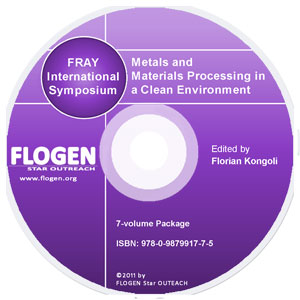
CD shopping page |
2011-Sustainable Industrial Processing Summit
|
| Editors: | Florian K |
| Publisher: | Flogen Star OUTREACH |
| Publication Year: | 2012 |
| Pages: | 646 pages |
| ISBN: | 978-0-9879917-6-8 |
| ISSN: | 2291-1227 (Metals and Materials Processing in a Clean Environment Series) |
OXYGEN PERMEATION STUDY ON TUBULAR MIXED IONIC AND ELECTRONIC CONDUCTOR CERAMIC MEMBRANES
Ensieh Ganji Babakhani1;1RESEARCH INSTITUTE OF PETROLEUM INDUSTRY, Tehran, Iran;
Type of Paper: Regular
Id Paper: 551
Topic: 9
Abstract:
There is a great interest in oxygen production according this fact that oxygen is an important common-used in chemical industry. Currently, oxygen is usually produced by cryogenic distillation or pressure swing adsorption, which is a very costly method. Perovskite ceramic membrane technology is good alternative which is more economical. In addition, the technology is compact and modular, and thus allows use in remote places. The general structure of the perovskite mineral is ABO3 (where A is rare and alkaline earth metal cation and B is a transition metal cation) which can be mixed oxygen ionic and electronic conductors (MIEC). In the ceramic membrane process ,when a gradient of oxygen chemical potential is imposed across these dense membranes at high temperatures, oxygen is transported in the form of oxygen ions from the high partial pressure side to the low partial pressure side and released downstream without the need of electrodes and external electrical loadings, which makes the system very simple.In this work a tubular perovskite membrane was prepared which posses more effective area in comparison to the disk type and is industrial applicable. BSCFO powder was synthesized by an EDTA-citric acid process and formed to the tubular shape via gelcasting method. Gelcasting is a method with a short forming time, high yields, high green capacity and low-cost machining, and has been used to prepare high-quality and complex-shaped dense/porous ceramic parts. Oxygen permeation through these membranes was studied by the GC method using a high-temperature permeation cell. This membrane was used successfully for oxygen separation at high temperatures. High permeation fluxes were achieved. The oxygen permeation flux was determined at different oxygen partial pressures of upstream and different temperatures between 750 and 950oC. The effects of air flow rate and sweeping helium flow rate on the oxygen permeation were also investigated.